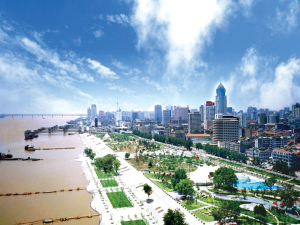In addition to being Central China’s transportation hub, Wuhan in Hubei Province is recognised as the third largest technological and educational centre in China behind Beijing and Shanghai. Shirley Zhang from Dezan Shira & Associates looks at this centre of finance, commerce, logistics and culture and reveals why it is colloquially known as the ‘golden key’ to the enormous markets located within China’s central regions.
 The Yangtze River runs through Wuhan giving rise to its nickname the ‘river city’, and as an important transportation hub for Central China it has also been called the ‘Chicago of China’. It has a Ming Dynasty-era idiom attributed to it —九省通衢 (jiu sheng tong qu) — meaning it is easily accessible by water or land from nine provinces: Sichuan, Shanxi, Henan, Hunan, Guizhou, Jiangxi, Anhui, Jiangsu and Hubei.
The Yangtze River runs through Wuhan giving rise to its nickname the ‘river city’, and as an important transportation hub for Central China it has also been called the ‘Chicago of China’. It has a Ming Dynasty-era idiom attributed to it —九省通衢 (jiu sheng tong qu) — meaning it is easily accessible by water or land from nine provinces: Sichuan, Shanxi, Henan, Hunan, Guizhou, Jiangxi, Anhui, Jiangsu and Hubei.
Economic Overview
In 2012, Wuhan’s GDP exceeded CNY 800 billion and grew at an annual rate of 11.4 per cent. Of this, Wuhan’s primary industry contributed CNY 30.1 billion (4.5 per cent growth) and its secondary industry CNY 387 billion (13.2 per cent growth). The remaining CNY 383.3 billion came from the service sector which grew 10 per cent year-on-year.
By the end of 2011, foreign investors from over 80 countries had made investments here, among which 5,793 foreign-invested enterprises had been established with actual foreign capital injections totalling USD 22.45 billion. A total of 84 Fortune 500 companies invested in Wuhan including Walmart, Shell, General Electric, General Motors, HSBC, Pepsi and IBM.
The average annual disposable income is CNY 23,738.09, which is expected to grow at 14 per cent every year. It hosts 158 large- and medium-sized supermarkets in addition to a combined 4,128 convenience stores, department stores and speciality shops, marking it as an expanding consumer market with huge potential.
Administrative Divisions
With more than 3,500 years of history, Wuhan was previously broken up in to three main towns — Wuchang, Hankou and Hanyang.
Wuchang was the political, educational and cultural centre; Hankou the transportation hub and centre for commerce and trade; and Hanyang the cradle of Wuhan’s modern industries. Despite some changes to administrative divisions the major functions of each remains essentially the same today.
The city is divided into two main parts — the central town and the new town — which comprise the following districts:
- Central Town: Jiang’an, Jianghan, Qiaokou, Hanyang, Wuchang, Hongshan and Qingshan
- New Town: East and West Lake, Caidian, Jiangxia, Huangpi, Xinzhou and Hannan
The Jiang’an, Jianghan, Qiaokou and East and West Lake districts were all split from the old Hankou area.
Local government statistics released in 2012 revealed that GDP growth rates of Wuhan’s new town districts were higher than those in central town across the board. The municipal National Development and Reform Commission estimated that the development zones and the six districts of the new town will generate at least CNY 120 billion more in 2013 that they did in 2012, which will establish it as a major support network for industrial development in the city.
Development Zones
Wuhan currently has three state-level development zones and three functional parks:
Development zones
- East Lake High-Tech Zone: focused on optoelectronic technique, biopharmaceuticals, energy and environmental protection.
- Wuhan Economic & Technology Development Zone: focused on automotive and electronics industries.
- Wuhan Airport Proximity Economic & Technology Development Zone: focused on food import, logistics and high-tech electromechanical products.
Functional parks
- Wuhan New Port: functions as a shipping hub in the middle reaches of the Yangtze River.
- Wuhan Chemical Industry Park: functions as a base and supply centre for petrochemical products as well as a logistical base for chemical products.
- Wuhan East Lake Scenic Area: functions as an ecotourism destination.
Investment Opportunities
Wuhan offers many preferential policies to foreign investors including tax incentives, discounted loan interest rates and subsidies. These preferential policies are generally offered to enterprises in the manufacturing and service-outsourcing industries, and are offered to all companies that establish headquarters in the city.
Further, financial incentives are given to foreign-invested banks and the local government provides favourable conditions for imported talent and their families with regard to obtaining visas and other relevant permits.
The city was founded primarily on the iron and steel, petrochemical, food, automobile, optoelectronics and equipment manufacturing. In addition to these pillar industries, Wuhan has further determined to prioritise its strategic emerging industries over the coming years, which include:
- New information technology;
- Energy saving and environmental protection;
- New energy;
- Biotechnology;
- New materials;
- High-end equipment manufacturing; and
- New energy automobiles.
Wuhan Municipal Science and Technology Bureau statistics state the high-tech industries in the city have realised annual growth rates of 26.2 per cent during the 11th Five-Year Period (2006−2011). Approximately CNY 11.37 billion has been granted to major scientific projects and 329 patents were awarded by 2012. Of the city’s 400 enterprises identified as high-tech, 24 of them realised annual outputs of over CNY 1 billion.
Dezan Shira & Associates is a specialist foreign direct investment practice, providing corporate establishment, business advisory, tax advisory and compliance, accounting, payroll, due diligence and financial review services to multinationals investing in emerging Asia. Since its establishment in 1992, the firm has grown into one of Asia’s most versatile full-service consultancies with operational offices across China, Hong Kong, India, Singapore and Vietnam as well as liaison offices in Italy and the United States.
To contact the firm, please email china@dezshira.com.


Recent Comments